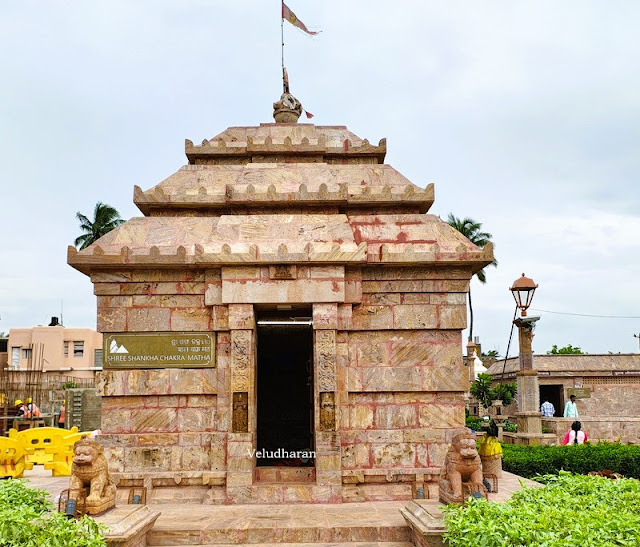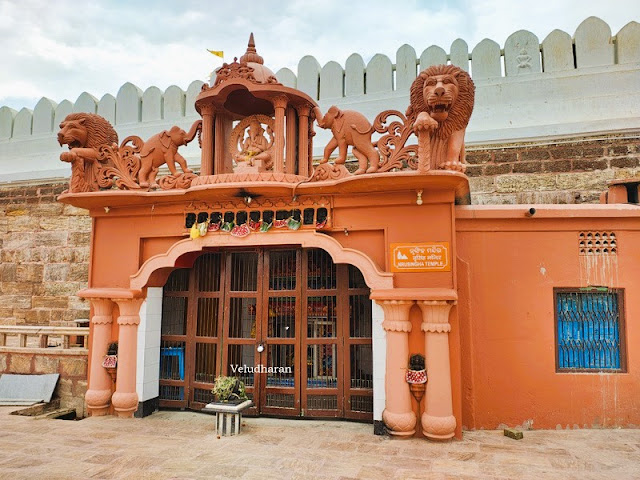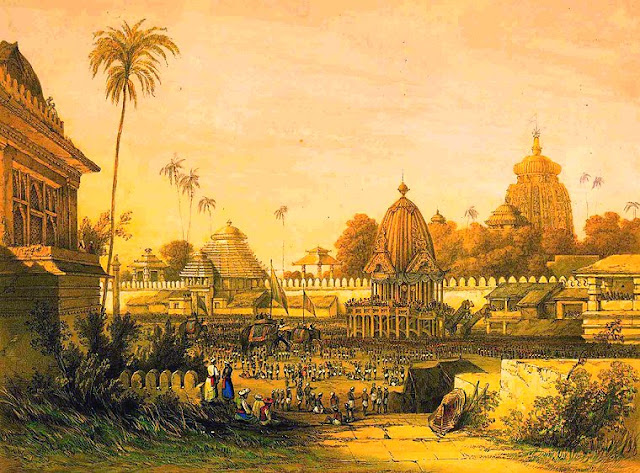The visit to this Sri
Jagannatha Temple at Puri, Odisha was a part of the “Kalinga and Ottara Desa
Heritage Walk” organised by சோழ மண்டல வரலாற்றுத் தேடல் குழு, between 13th to 18th September 2024. The purpose of this Heritage walk was to see the places,
monuments, etc., which are directly or indirectly connected as proof of
Rajendra Chozha’s victory mentioned in his meikeerthi/title over Kalinga and
Ottara Desa, the present Andhra Pradesh and Odisha.
Moolavar : Sri Jagannath,
Balarama and Subatra.
Some of the salient features
of this temple are…..
The temple faces east and
Devotees are allowed for darshan only through the East side gate, also called as
Lion gate. The other three gates are used only for existing purposes. Sri Jagannath, Balarama and Subadra is in the
Sanctum Sanctorum. The main idols are made of neem wood, which will be replaced
once in 19 years.
In praharam Sri Ma Vimala
Devi, Sri Gopeswar Temple, Sri Sakhigopal temple, Kanchi Ganesh Temple,
Gopinath Temple, Bhuvaneswar sannidhi, Sakthi, Gayathri sannidhi, Ma Maha
Lakshmi sannidhi, Nilam Dabha, Vishwakarma sannidhi, and Ratha, Balarama,
Lakshmi Narayana, Surya and Bhadra kali Sannidhi.
ARCHITECTURE
The main temple is
built on a raised platform, built in Kalinga architectural style. The temple consists
of a Sanctum Sanctorum with Vimana, Jagamohan, Nata Mandapa, and Bhoga Mandapa.
The Vimanam over the Sanctum sanctorum and Jagamohan is of Rekha Deula and Pidha
Deula. The Vimanam over the sanctum sanctorum is of Nagara type in Rekha Deula
style and the Jagamohana is of Pidha Deula style.
The Vimana has a
Pancharatha ground plan with a vertical shape at the bottom and a curvilinear spire
(Shikhar). Inside the Vimana, the idols of the main deities have been installed
on a stone pedestal called Ratna Singhashana.
The nata mandapa Vimana is
plain and Bhoga mandapa is with Pitha Deula/Vimana. The
entrance mandapa is also similar to Pitha Deula/Vimana.
HISTORY AND INSCRIPTIONS
As per the Kendupatna Copper plate
inscriptions, the temple was rebuilt by the King of the Eastern Ganga dynasty,
Anantavarman Chodaganga, in the 10th century CE, his descendant, Narasimhadeva-II
and a relative Rajendra Chola from the mother side. An 1134–1135 CE inscription
records his donation to the temple. However, the construction was completed in
1230 CE, during the reign of Anangbhima Deva-III. The main deities are also
installed and consecrated, by him.
As per the history, Anangabhima Deva-III established many endowments and numerous bhogas and festivals. For the same, he
had gifted many lands and gold to the temple.
The inscriptions of Suryavamsi rulers who
succeeded the Gangavansis, record the lavish gifts and the strict follow-up of
the rituals and festivals.
In 1568 CE, the power of Gajapati Prataprudra
Deva declined due to the death of Mukunda Deva, the last independent Hindu
King of Odisha. Afghan rulers under General Kalapahad captured Odisha, looted temple properties, and destroyed most of the images and the temple.
In 1575 CE, King Rama Chandra Deva-I of the Bhoi dynasty established a new Kingdom after throwing out the Afghan rulers,
keeping Khurda as Capital, installed back the deities in the Sanctum Sanctorum.
From 1682 to 1707 Lord Jagannath was hidden and Rath
Yatra was stopped for 25 years till the end of rule by Aurangzeb. Somehow the
temple survived various assaults on it. The local Kings and the temple priests
had their role in preserving the temple intact. Possibly the local Muslim
rulers might have spared the temple after looting the treasure.
Raja Mansingh, a Mughal general, under the
Moghul Emperor Akbar, announced Rama Chandra Deva, the Gajapati ruler of
Khurda, since Shri
Rama Chandra Deva converted himself to Islam to protect his kingdom and the
temple and renamed him Hafiz Kader. After the fall of Moghuls, Odisha was passed into the hands of the
Marathas.
In 1751 a treaty was reached between Nawab
Alivardi Khan of Bengal and Raghuji Bhonsla of Nagpur, the province of Cuttack
i.e., Odisha as far as the river Subarnarekha was ceded to the Marathas over
which they become the de facto rules. The Marathas, under Subhadar Sheo Bhatta, kept the management of Shree Jagannatha Temple, whereas the authority of the
Rajas of Khurda was very limited.
In 1803 CE the management was taken over by the
Governor-General, Lord Wellesley, East India Company of British rulers, once
again they entrusted the power of management of the temple to the Rajas of
Khurda.
A huge property was allotted for the services
of the deities and granted annually an amount of 53,000/- rupees on average, towards temple expenses.
Queen Suryamani, who took over the management of
the temple efficiently for 33 years from 1860 to 1897 CE played a major
role in the history of this Shree Jagannath Temple. (Excluding the period during which Dibyasingh
Dev was the superintendent i.e. from 1875-1878). From 1889 to August 1926, under
pressure from the government, the king of Puri was forced to bring a Deputy
Magistrate on deputation as Manager of the temple.
The Government of Odisha, passed an act in
1951, to protect the huge endowed properties, to regulate the worship, Sevas, rituals, celebrations, duties, and responsibilities of officials, Sevaks,
Pujaris, and as many as 119 categories.
Further, an exclusive Shree Jagannatha Temple
Act, 1954 (Orissa Act 11 of 1955) was passed. The Act became Law in November 1955 Shree Jagannatha Temple Act, 1954 forms the basis of the existing
administrative pattern of the temple and its endowments. The Act came into force
with effect from 27.12.1960. After the introduction of the Shri Jagannatha Temple
amending Act, 2004 the Managing Committee as well as the administrative structure
has been upgraded with effect from February 2005.
Ref:
The Temple’s website.
LEGENDS
As per the legend, a king named
Indradyumna, an ardent devotee of Maha Vishnu, wishes to have the darshan of
Maha Vishnu. One day a Brahmin, who met the King, told that Maha Vishnu had
incarnated as Nila Madhava, in a little faraway place. On hearing this, the
King sent many priests to find the exact place. All the priests returned back
except Vidyapati. Vidyapati was able to locate a Village Chief, Visvavasu, who
knows the place of Nila Madhava. To his request, Visvavasu declined to take him
to the place where Nila Madhava was staying. The priest stayed in the same
Village and married the Visvavasu’s Daughter. As a Son-in-law, Vidyapati was
able to persuade Visvavasu to accept his request.
Vidyapati was
blindfolded, during the Journey. But Vidyapati managed to take the mustard
seed, which he dropped throughout the route. On reaching the place Vidyapati
had the darshan of Nila Madhava and returned back with a blindfold.
Vidyapati came
to the King and narrated the story of the Darshan of Nila Madhava along with
Visvavasu, his father-in-law. Vidyapati took the King to the place where Nila
Madhava stayed, following the mustard seeds dropped route. Finally, they reached
the place but couldn’t have the darshan. Instead, the king heard a Divine
Voice and asked him to go to Puri where he would find a tree log floating in the
sea and make an idol and worship. Called the expert sculptors and asked them to make the idol. The Sculptors could not make the Idol of God, since nobody had
seen the God and their chisel couldn’t penetrate the log of wood.
On knowing this,
the Vishvakarma, as a sculptor came forward to make the idol, on one condition
that he should not be disturbed till he completes the idol. Days passed, and the
Queen couldn’t control her curiosity to see the progress of the idol. To
her disappointment, three idols half-finished are found in the room, and
couldn’t find the sculptor. From the day onwards, these unfinished idols of Jagannadh,
Balabharda/Balarama, and Subhadra are worshipped as deities.
The images of Sri Jagannath, Balarama, and
Subatra, in Sanctum Sanctorum, are made of neem wood. The same will be replaced
with replica images, once in 19 years and the last replaced in 1996 and May
2015. As per the legends, it is believed
that Krishna’s/Balarama's heart also called Brahman, is functioning and the
wood will damage the heart. Hence the Heart will be replaced with the new idol.
The priest will do it blindfolded and hands are covered with Cloth. The priest
says it will be a powerful feeling, it forms a light, jumps, and is difficult to
hold. During changing the total lights will be switched off in and outside the
temple, which includes the total City of Puri.
The Vaishnava saints, Ramanujacharya,
Madhvacharya, Nimbarkacharya, Vallabhacharya, and Ramananda visited this temple.
Ramanuja established the Embar Mutt in the south-eastern corner of the temple,
and Adi Shankara established the Govardhan Math, which is the seat of one of
the four Shankaracharyas. It is also of particular significance to the
followers of Gaudiya Vaishnavism, whose founder, Chaitanya Mahaprabhu, was
attracted to the deity, Jagannath, and lived in Puri for many years
The following are the myths that revolve around this
Puri Jagannath Temple.
1. The flag atop the temple always flaps in the
opposite direction of air.
2. From any place in Puri, only the flat face of
the chakra can be seen.
3. During the daytime, air comes from sea to land
& during the evening, the vice-versa occurs. But in Puri, it’s totally opposite.
4. No birds or planes fly above the temple.
5. The shadow of the main dome is invisible at
any time of the day (maybe only during noon time).
6. The quantity of cooked food inside the
Temple remains the same for the entire year. But that same quantity of prasad can
feed a few thousand people & 20 lakh people, Still, it won’t get short or
excess.
7. In the Temple kitchen, 7 pots are kept one
on top of another and cooked on firewood. In this process, the contents in the
top pot get cooked first & then the bottom one.
8. After entering from Singhadwara’s first step
(from inside the Temple), you cannot hear any sound of the waves of the
ocean. But, when you cross the same step (from outside of the Temple) you can
hear it. This can be noticed clearly during the evening.
POOJAS AND CELEBRATIONS
Devotees are allowed in stages depending on the
poojas. The temple opens at 05.30 hrs and after Mangal Aarati Devotees are
allowed entry up to Jagamohan. After Gopal Pallav pooja devotees are allowed up to
Naatamandir, After Sakaal Dhoopa devotees are allowed up to Jagamohan, till the completion of Bhoga mandap pooja. Ardha Jama pooja will be conducted around
21.00 hrs.
General and outside Devotees are allowed
through the east Side gate/Lion Gate, whereas the officials and the local people
are allowed through the other three gates.
Important festivals are Snana Yathra/ Bathing festival, Ratha Yatra, Sayana
Yathra, Dakshinayana, Parshwa Parivartana, Deva Utthapana, Pravarana Sasthi,
Pushyavisheka, Makars Sankranti, Dola yatra, Damanaka Chaturdasi, Akshaya
Thiruthya / Chandana Yathra, and Neeladri Mahodya.
PC- Website
PC- Website
CONTACT DETAILS
The temple landline numbers are...
+916752222002 may be contacted for further details.
The website of the temple- https://www.shreejagannatha.in/
The e-mail address jagannath.or@nic.in
HOW TO REACH
From Puri Bus terminus, Auto rickshaws are
available. Private, Buses and Vans are not allowed near the temple.
The temple is about 1.6 km from Puri Bus Stand,
2.5 km from Puri Railway station, 36 km from Konark Sun Temple, 60 km from Biju
Patnaik Airport, Bhubaneswar, and 83 km from Cuttack.
Nearest Railway Station is Puri.
LOCATION OF THE TEMPLE: CLICK HERE
PC- Website
In the tradition of Sri Jagannatha of Puri, Navagunjara is considered to represent Eswara (Supreme One) and as the Visva-rupa (Universal Form) of
Krishna, an incarnation of Vishnu. The composite figure consists of the head
and neck of a peacock, a slender waist topped with the hump of a bull, and a
serpent as the tail. The figure stands on the three legs; the left foreleg that
of an elephant, and the hind legs that of a tiger and deer. The right foreleg,
in the form of a human hand, holds a lotus in full bloom. In a few examples,
the head of a rooster is shown instead of the peacock. In my opinion, the
peacock’s head perfectly suits the form as the myth is associated with Krishna,
whose head is often decked with the feather of a peacock. It is believed
that Arjuna Worshipped Navagunjara of this temple.
PC- Website
--- OM SHIVAYA NAMA---
NOTE
Some of the pictures are taken from the website. Thanks to the unknown photographers and artists.







_of_Jagannath_temple,_Puri.jpg)













No comments:
Post a Comment